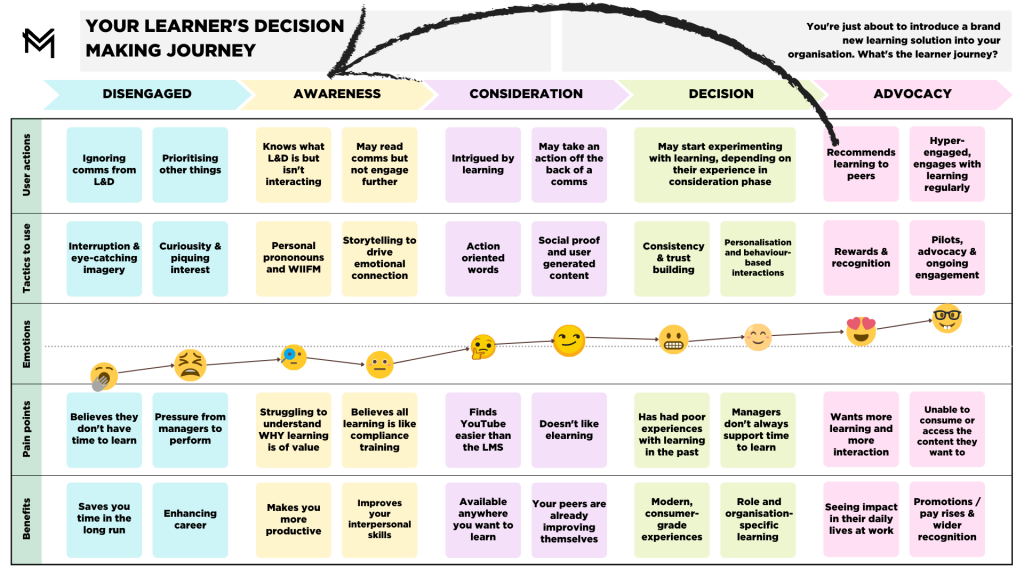want some cookies?
We use cookies to make your browsing experience amazing.

TRANSFORM YOUR COMMUNICATIONS IN LEARNING
Did you know that the average person has to see a brand at least seven times before they’re able to recall it? People are awfully forgetful, and awful at remembering your learning. That means that getting their attention (and keeping it!) is going to take a heck of a lot more comms than a single email or a Yammer post.
So what can you do to keep front of mind with your people and ensure that they are perpetually engaged with your learning? Consider using the decision making journey, the new saviour to your engagement issues (newsflash: it’s still Marketing for Learning®).
WHAT IS A DECISION MAKING JOURNEY?
For some reason, when it comes to getting our audiences connected to learning, we tend to seek out quick solutions. But poor learner engagement is actually a very complex problem and you may find yourself asking questions such as the below:
“How do I continue people to engage with learning?”
“Why aren’t my learners opening my emails?”
“What am I supposed to do to persuade my audience to learn?”
Let me repeat. There is no quick fix. Just lots of hard work and a deep understanding of the foibles of your audience. My advice? If you want your learners to, uh, learn, then be with them through every single step of their decision making process (or journey) and support them to ‘transact’ with you (i.e. give you their time).
PERSUASION TAKES MORE THAN MINIMAL COMMS
Unfortunately, getting your largely disconnected workforce deeply engaged with learning isn’t a matter for a few emails (no matter how well-worded and well-intentioned they are). It’s going to take multiple touchpoints that are spread consistently across a longer timeframe than ‘crap we have this thing launching and we need to tell people about it’.
After all, you’re looking to influence, build trust with our audience and persuade them to do something that they may not want to do. You’re building positive associations with your brand and that effort deserves more than ad-hoc, at-the-last-moment comms.
Rather than look at the quick kill solution, which, let’s be honest, isn’t going to get you results anyway, consider digging more deeply into the learner perspective. What do they want and need? Do they even know your learning exists? Do they think it’s valuable?
This stuff takes time, and I am going to show you how to use this time to help your learners navigate through a simple decision making process. I’ve essentially adapted a buying funnel in marketing for our L&D audiences. Let’s walk through it.
USING THE LEARNER JOURNEY AND KEY STAGES OF AWARENESS
As much as we’d love to believe that all of our learners are hyper-engaged with learning and JUST PLAIN LOVE IT, we know that’s not the truth. Look at the simple process I have mapped out below, you can clearly see that most ‘consumers’ (read: your learners) will go through several stages of decision making before they’ll ‘convert’ (ie, start doing some learning). There are five stages in total: disengaged, awareness, consideration, decision, and advocacy.

Let’s explore the different stages and how a learner may behave in each one.
1. DISENGAGED
In this stage, it’s pretty widely accepted that your audience does not want to learn. They’re likely ignoring your comms and don’t believe learning is of value. At this stage in a decision journey, the learner does not want to be SOLD to and my best advice is plainly to accept that they are fully disengaged.
WHAT YOU CAN DO AT THIS STAGE: At this stage, we should focus on getting attention. We want to interrupt people and pique their curiousity. We want them intrigued and we don’t want to give much away. Do not SELL learning, and DO NOT send them links to elearning modules or your LMS.
Think of your comms as teasers, little bites of something that they don’t have the full view of yet.
2. AWARENESS
At this stage, your audience may be somewhat aware of L&D and what you offer to them, but they still remain on the periphery of activities. They’re not yet engaged, but you may partially have their attention and they have absorbed some of the early information you have sent to them.
WHAT YOU CAN DO AT THIS STAGE: Eat, sleep and breathe the learner and make your communications all about them. Really focus on the WIIFM and lean into the benefits of learning for them. Never focus on features of your learning products; in my experience learners just plain don’t care about this. Also make sure you are still incorporating activities from step 1.
3. CONSIDERATION
OK, OK, you definitely have their attention now. What are you going to do with it? I suggest at this stage moving to much more action-based language and prompts. Maybe finally send them to the learning platform or some other cool learning stuff you’ve got going on. They’re very much considering the value of learning at this stage, so bring out the big guns - there’s nothing worse than over promising and under delivering.
WHAT YOU CAN DO AT THIS STAGE: Create a sense of urgency. Use power words and action words. Validate that learning is of value using user-generated content and social proof. PROVE TO THEM IT'S WORTHWHILE. Don’t forget to incorporate activities from steps 1 & 2.
4. DECISION
Good news guys, your audience is now learning a bit more now (as long as their experiences in Step 3 are good. If they're bad, you're back to step one sadly). Prompted by your comms, they're engaging with learning content and dabbling in the joyful experiences you provide. So keep the momentum going and compound their positive experiences to help solidify a positive attitude and sentiment towards your learning.
WHAT YOU CAN DO AT THIS STAGE : Capitalise on your now captive audience; consistently connect to further build on trust creation. Personalise and use behaviour-based interactions where possible. Incorporate activities from steps 1, 2 and 3.
5. ADVOCACY
OH YEAH. Your people literally LOVE learning and are even recommending their positive experiences to their peers. The marketing magic is truly starting to happen and people are doing the work for you by spreading the word about learning. Beautiful.
WHAT YOU CAN DO AT THIS STAGE: Use their voices to support activities in. Step 3. Enable them to amplify your voice and equip them with the tools to do so. Incorporate all 4 previous steps.
And that’s it, the five stages most learners will go through at some point in their career with your organisation. But before you start using this with fervour, remember: this is a very linear version of a buyer's journey, used to plainly map out someone's consideration stages. Not everyone will follow this journey exactly, for example, they may go straight from step 1 to step 4, or they may already be at step 3. This is why I have suggested you incorporate all the previous steps in the later phases, to ensure you are covering all the bases.
IMPROVE YOUR RELEVANCY, POSITIONING AND MESSAGING
People ask me a lot about how you can actually use this process in practice. It is a really useful tool to support you in adjusting your messaging to your audiences. For example, consider the way you might communicate with someone at the disengagement stage vs the advocacy stage. Let’s look at an example:
The L&D department at an FMCG organisation is trying to rally up engagement for their newly launched LXP that’s called Orion. They do have some active users, but about 65% of the workforce is yet to even login. Let’s look at how they might communicate with these two differing audiences.
DISENGAGEMENT: Tired of looking for stuff you can’t ever find? Orion knows.
ADVOCACY: How has Orion helped you today? Tell us now to win a £50 Amazon voucher
It’s an incredibly rudimental example, but at its core, you can clearly see how different this messaging will be. Therefore it’s essential that you consider what stage of a buyer’s journey your learner is at when drafting comms (and of course, never forget the WIIFM!)
Please bear in mind that this is very basic. It is designed to give you an idea of the different emotions, pain points, and actions a person might take BEFORE they ever interact with your learning (barring a wee dabble here and there).
You want them to learn?
Join them on their journey.
And communicate in a way that makes sense to them.
Happy journey mapping friendo.









